*NURSING > QUESTIONS & ANSWERS > WGU C790 NURSING INFORMATICS QUESTIONS AND ANSWERS 100% CORRECT (All)
WGU C790 NURSING INFORMATICS QUESTIONS AND ANSWERS 100% CORRECT
Document Content and Description Below
WGU C790 NURSING INFORMATICS QUESTIONS AND ANSWERS 100% CORRECT goal of EBP ✔✔is improvement of systems and microsystems within healthcare, with these improvements based on science STEEEP prin... ciples ✔✔The Institute of Medicine (IOM) expert panel issued recommendations for urgent action to redesign healthcare so that it is safe, timely, effective, efficient, equitable, and patient-centered (S) in STEEEP ✔✔Safe-Avoid injuries to patients from the care that is intended to help them. (T) in STEEEP ✔✔Timely-Reduce waits and sometimes harmful delays for both those who receive and those who give care. (E) in STEEEP ✔✔Effective-Provide services based on scientific knowledge to all who could benefit, and refrain from providing services to those not likely to benefit. (E) in STEEEP ✔✔Efficient-Avoid waste, including waste of equipment, supplies, ideas, and energy. (E) in STEEEP ✔✔Equitable-Provide care that does not vary in quality because of personal characteristics such as gender, ethnicity, geographic location, and socioeconomic status. (P) in STEEEP ✔✔Patient-centered Provide care that is respectful of and responsive to individual patient preferences, needs, and values, and ensure that patient values guide all clinical decisions. ACE Star Model of Knowledge Transformation Advancing Research and Clinical Practice through Close Collaboration (ARCC) Model of Evidence-Based Practice in Nursing and HealthcareJohns Hopkins Nursing Evidence-Based Practice Model and Guidelines Iowa Model of Evidence-Based Practice Stetler Model of Research Utilization ✔✔FOCUS: EBP, research use, and knowledge transformation processes DESCRIPTION: Direct a systematic approach to synthesizing knowledge and transforming research findings to improve patient outcomes and the quality of care Address both individual practitioners and healthcare organizations Focus on increasing the meaningfulness and utility of research findings in clinical decision making Promoting Action on Research Implementation in Health Services (PARiHS) Vratny and Shriver Model for Evidence-Based Practice Pettigrew and Whipp Model of Strategic Change Outcomes-Focused Knowledge Translation Determinants of Effective Implementation of Complex Innovations in Organizations Ottawa Model of Research Use ✔✔FOCUS: Strategic and organizational change theory to promote uptake and adoption of new knowledge DESCRIPTION:Trace mechanisms by which individual, small group, and organizational contexts affect diffusion, uptake, and adoption of new knowledge and innovation Premise is that interventions, outcomes evaluations, and feedback are important methods to promote practice change Collaborative Model for Knowledge Translation between Research and Practice Settings Framework for Translating Evidence into Action Knowledge Transfer and Exchange Canadian Institutes of Health Research Knowledge Translation within the Research Cycle Model or Knowledge Action Model Interactive Systems Framework for Dissemination and Implementation ✔✔FOCUS: Knowledge exchange and synthesis for application and inquiryDESCRIPTION: Structure ongoing interactions among practitioners, researchers, policy-makers, and consumers to facilitate the generation of clinically relevant knowledge and the application of knowledge in practice All parties are engaged in bidirectional collaboration across the translation continuum Knowledge Transformation ✔✔(Ace Star Model) is defined as the conversion of research findings from discovery of primary research results, through a series of stages and forms, to increase the relevance, accessibility, and utility of evidence at the point of care to improve healthcare and health outcomes by way of evidence-based care. Ace Star Model ✔✔These five points are discovery research, evidence summary, translation to guidelines, practice integration, and evaluation of process and outcome clinical practice guidelines (CPGs) ✔✔The IOM defines clinical guidelines as "systematically developed statements to assist practitioner and patient decisions about appropriate health care for specific clinical circumstances. usability ✔✔1.Increased user productivity and efficiency 2.Decreased user errors and increased safety 3.Improved cognitive support human factors ✔✔is "the scientific discipline concerned with the understanding of interactions among humans and other elements of a system, and the profession that applies theory, principles, data and methods to design in order to optimize human well-being and overall system performance." In healthcare, human factors might concern the design of a new operating room to better support teamwork and patient flow. ergonomics ✔✔used interchangeably with human factors by the HFES in Europe but in the U.S. and other countries its focus is on human performance with physical characteristics of tools, systems, and machines i.e. power drill fitting in handHuman-computer interaction (HCI) ✔✔is the study of how people design, implement, and evaluate interactive computer systems in the context of users' tasks and work usability ✔✔is often used interchangeably with HCI when the product is a computer but usability also concerns products beyond computers. Usability is also more focused on interactions within a specific context or environment for a specific product. Formally, the ISO defines usability as the extent to which a product can be used by specific users in a specific context to achieve specific goals with effectiveness, efficiency, and satisfaction. allows users to achieve goals joint cognitive systems ✔✔imply that information is shared or distributed among humans and technology. This framework is useful for examining teamwork in healthcare where team members work together on patient care Health Human-Computer Interaction (HHCI) Framework ✔✔Humans or products can initiate interactions. The information is processed through either the product or the humans according to characteristics. The recipient then reacts to the information; for example, a healthcare provider could read and respond to email from a patient or a product might process interactions after the "enter" key is pressed. Iterative cycles continue as humans behave and products act according to defined characteristics. Goals and planning are implicit within the tasks displayed in the framework. discount usability methods ✔✔reduce the number of required users in usability projects and to use early design prototypes. These methods offer economies of time, effort, and cost and can be completed at any point in the systems life cycle. Two common techniques are heuristic evaluation and think-aloud protocol.Heuristic evaluations ✔✔compare products against accepted usability guidelines to reveal major and minor usability issues. think-aloud protocol ✔✔also involves a small number of users and has them talk aloud while they interact with a product. Users voice what they are trying to do, indicate where interactions are confusing, and provide other thoughts about the product during interactions. This allows a detailed examination of the specified tasks, in particular to uncover major effectiveness issues. used in conjunction with other techniques task analysis ✔✔generic term for a set of more than 100 techniques that range from a focus on cognitive tasks and processes (called cognitive task analysis) to observable user interactions with an application (e.g., a systematic mapping of team interactions during a patient code). Task analyses are systematic methods that are used to understand what users are doing or required to do with a product by focusing on tasks and behavioral actions of the users and products. These methods provide a process for learning about and documenting how ordinary users complete actions in a specific context. Methods of task analysis include the following: •Interviews •Observations •Shadowing users at their actual work sites •Observing users doing tasks •Conducting ethnographic studies or interviews focused ethnographies ✔✔concentrate on individuals' points of view, their experiences and interactions in social settings, rather than on just the actions of those individuals During observations, detailed descriptions are generated with an emphasis on social relationships and their impact on work.Usability Questionnaires ✔✔System Usability Scale (SUS)- industry standard, 10-scale Questionnaire for User Interaction Satisfaction (QUIS)-computer system or application assessed Purdue Usability Testing Questionnaire-100 open ended questions Software Usability Measurement Inventory (SUMI)- Exploratory Test ✔✔conducted early in the systems life cycle after requirements are determined. These tests are conducted on very basic or preliminary designs or redesigns where few resources have been committed to programming the product. The objective of an exploratory test is to assess the effectiveness of emerging design concepts informal Assessment Test ✔✔conducted early in or midway through the development of a product application. After the organization and general design are determined, this kind of test assesses lower-level operations of the application, stressing the efficiency goals of the product (versus effectiveness) and how well the task is presented to users. conducted whens system partially developed validation test ✔✔completed later in the systems life cycle using a more mature product. This type of test assesses how this particular product compares to a predetermined standard, benchmark, or performance measure. Comparison Study ✔✔can conduct comparison studies at any point in the systems life cycle but they are more commonly done to compare an existing design with a redesign or an early prototype with a more mature product. The major objective of this usability test is to determine which application, design, or product is more effective, efficient, and satisfyingSteps for Conducting Usability Tests ✔✔1) define a clear purpose 2) assess constraints 3) Use an HCI framework to define pertinent components. 4) Match methods to the purpose, constraints, and framework assessment. human factors ✔✔The complex interactions among multiple users, products, and environments with varying characteristics in health information technology is referred to project ✔✔is a planned undertaking, with a beginning and end that produces a well-defined result or product. information system development project ✔✔a planned undertaking that produces a new information system predictive approach to the SDLC ✔✔assumes that the development project can be planned and organized and that the new information system can be developed according to the plan useful for building systems that are well understood and defined. company may want to convert its old networked client/server system to a newer Web-based system that includes a smartphone app. In this type of project, the staff already understands the requirements very well, and no new processes need to be added traditional (70s-90s) adaptive approach to the SDLC ✔✔is used when the system's requirements and/or the users' needs aren't well understood. In this situation, the project can't be planned completely. Some system requirements may need to be determined after preliminary development work.(late 90s-today) project initiation (predictive) ✔✔In predictive approaches, there is a group of activities that identifies the problem and secures approval to develop a new system Project planning (predictive) ✔✔In predictive approaches, there is a group of activities that identifies the problem and secures approval to develop a new system map out the project's overall structure analysis (predictive) ✔✔focuses on discovering and understanding the details of the problem or need. The intent here is to figure out exactly what the system must do to support the business processes design (predictive) ✔✔focuses on configuring and structuring the new system components. These activities use the requirements that were defined earlier to develop the program structure and the algorithms for the new system implementation (predictive) ✔✔includes programming and testing the system. deployment (predictive) ✔✔involves installing and putting the system into operation. phases of the system development project (predictive) ✔✔project initiation, project planning, analysis, design, implementation, and deployment support phase (predictive) ✔✔includes the activities needed to upgrade and maintain the system after it has been deployed. The support phase is part of the overall SDLC, but it isn't normally considered part of the initial development project waterfall model (predictive) ✔✔the phases of the project flow down, one after another.This model assumes that the phases can be carried out and completed sequentially. After a project drops over the waterfall into the next phase, there is no going back rigid planning, doesn't work very well interative approach (adaptive) ✔✔Using iterations, the project is able to adapt to any changes as it proceeds. Also, parts of the system are available early on for user evaluation and feedback, which helps ensure that the application will meet the needs of the users. [Show More]
Last updated: 1 year ago
Preview 1 out of 39 pages

Also available in bundle (2)

WGU C790 NURSING, BUNDLE. ONLY MOST EXAMINABLE QUESTIONS, RATED A
DOWNLOAD TO SCORE A.EXAMINABLE QUESTIONS, RATED A
By bundleHub Solution guider 1 year ago
$17
5
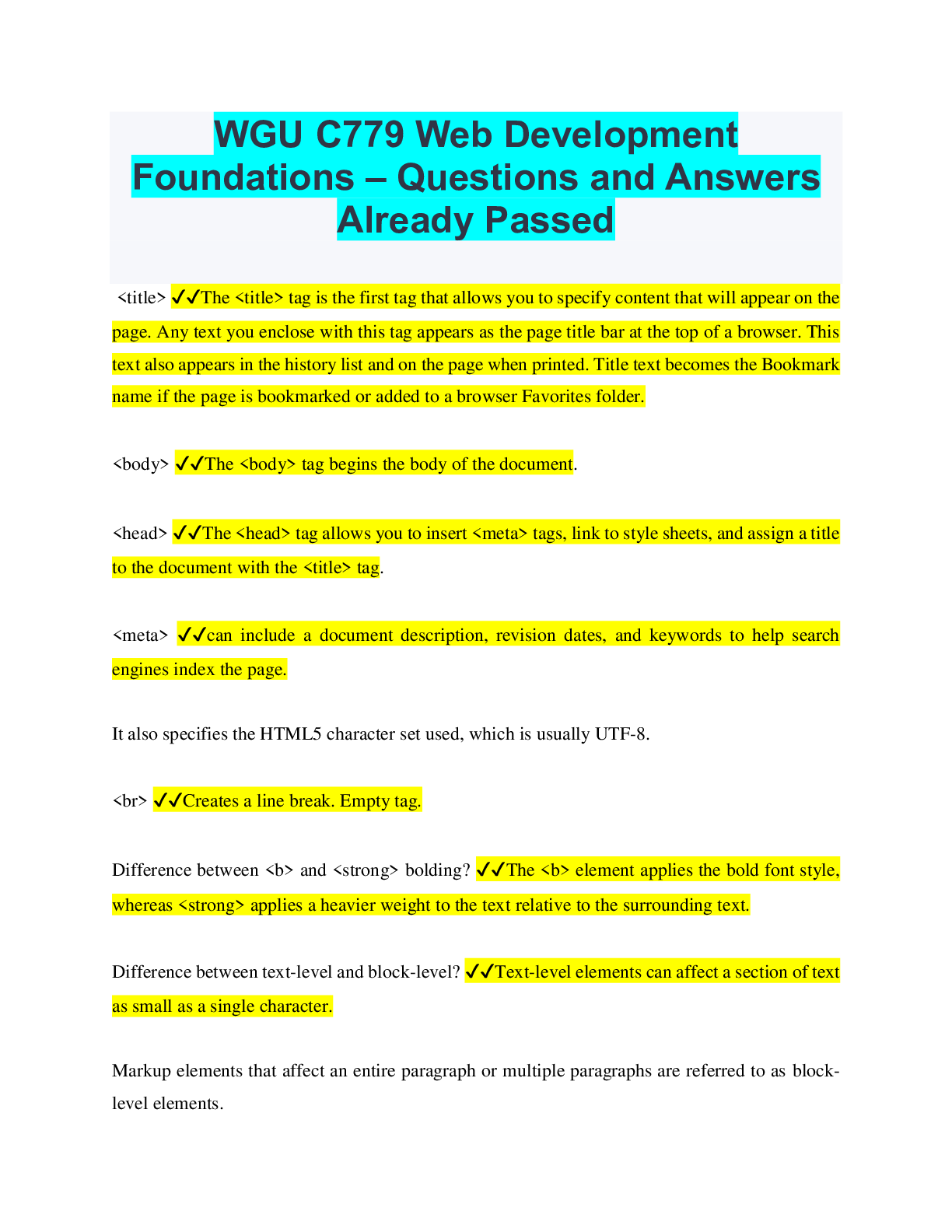
ALL PSYCHOLOGY EXAM QUESTIONS WITH ANSWERS DOCUMENTS. LATEST 2022/2023. RATED A
ALL YOU NEED TO PASS THE PSYCHOLOGY 101. ACCURATE ANSWERS, 100% PRECISE AND EASY READING DOCUMENTS. RATED A
By bundleHub Solution guider 1 year ago
$40
75
Reviews( 0 )
Document information
Connected school, study & course
About the document
Uploaded On
Oct 01, 2022
Number of pages
39
Written in
Additional information
This document has been written for:
Uploaded
Oct 01, 2022
Downloads
0
Views
178





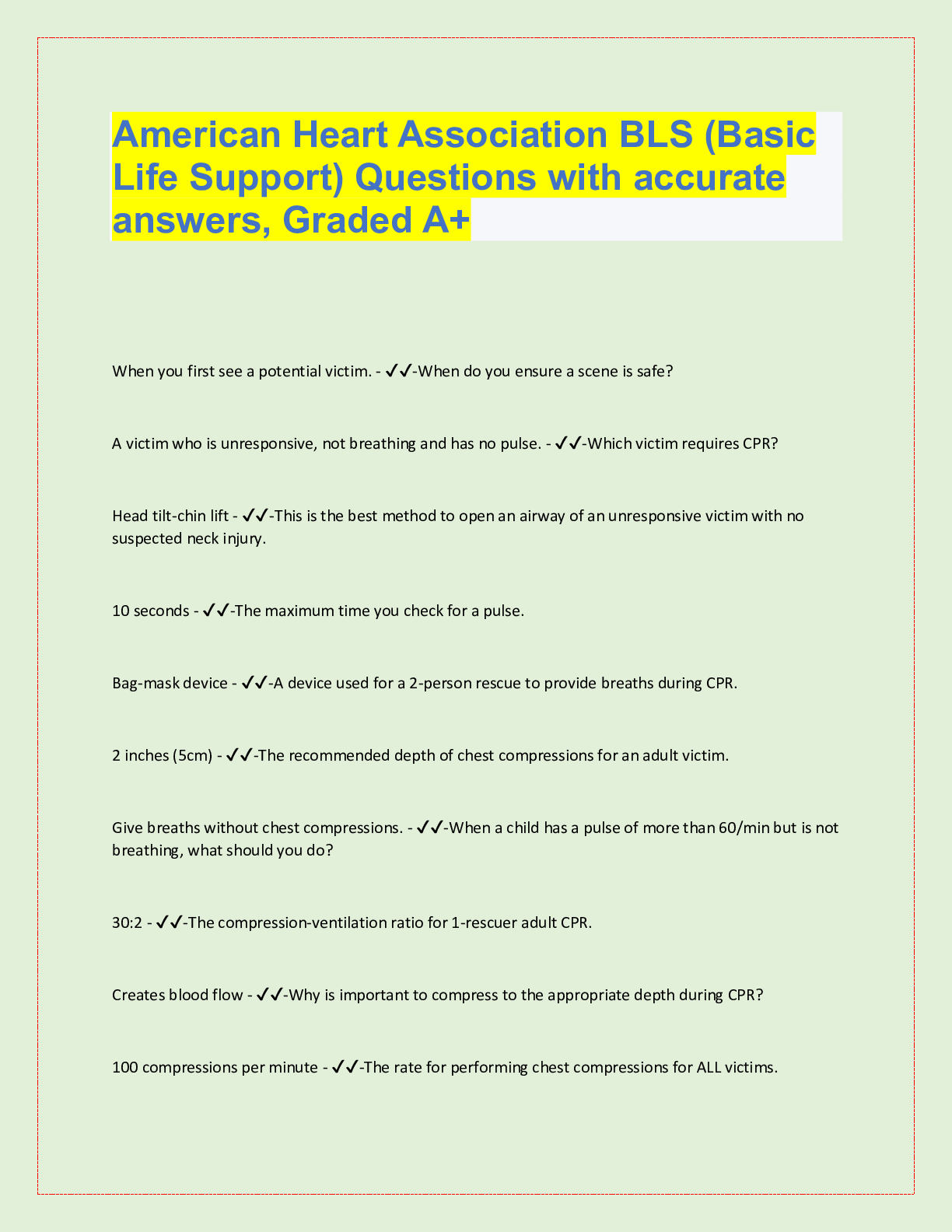


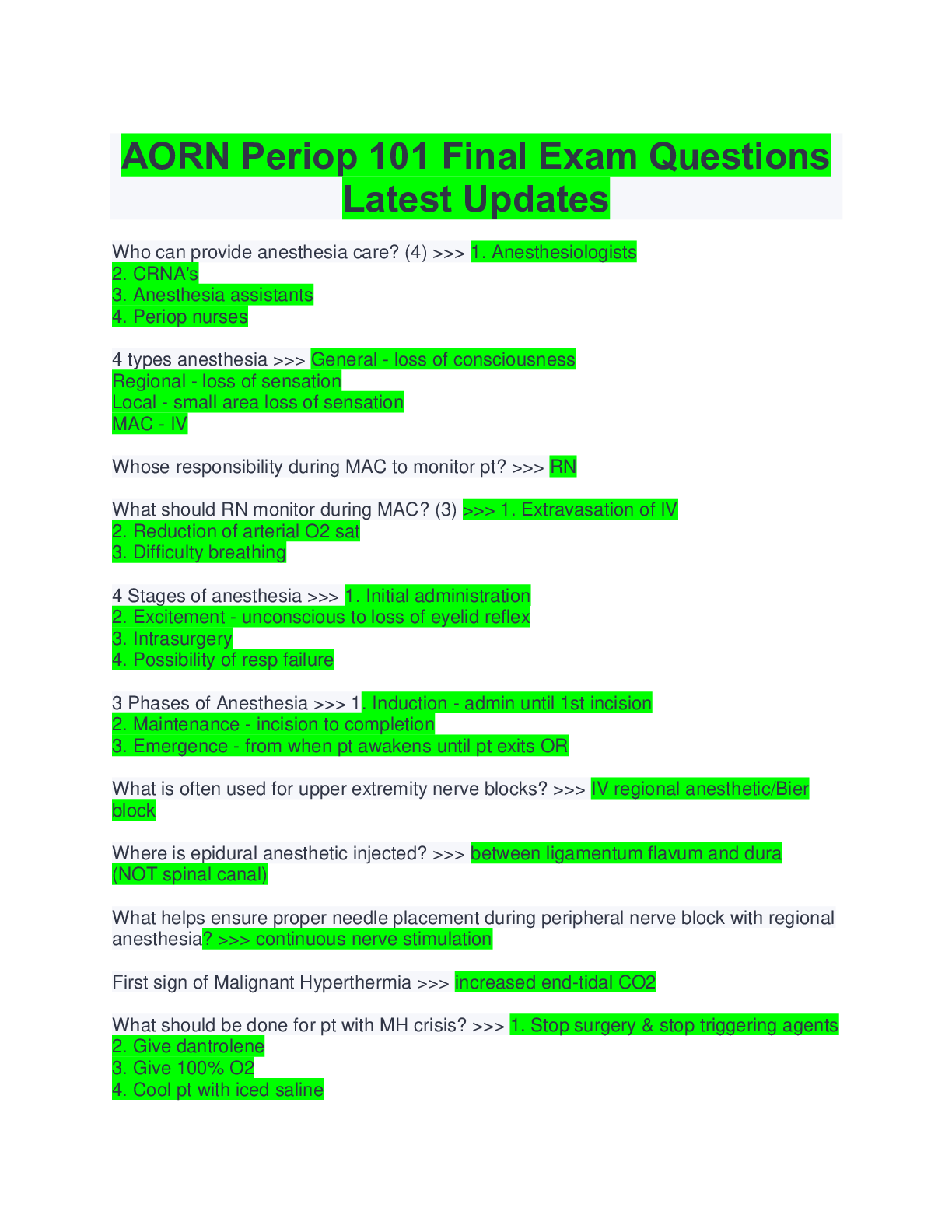






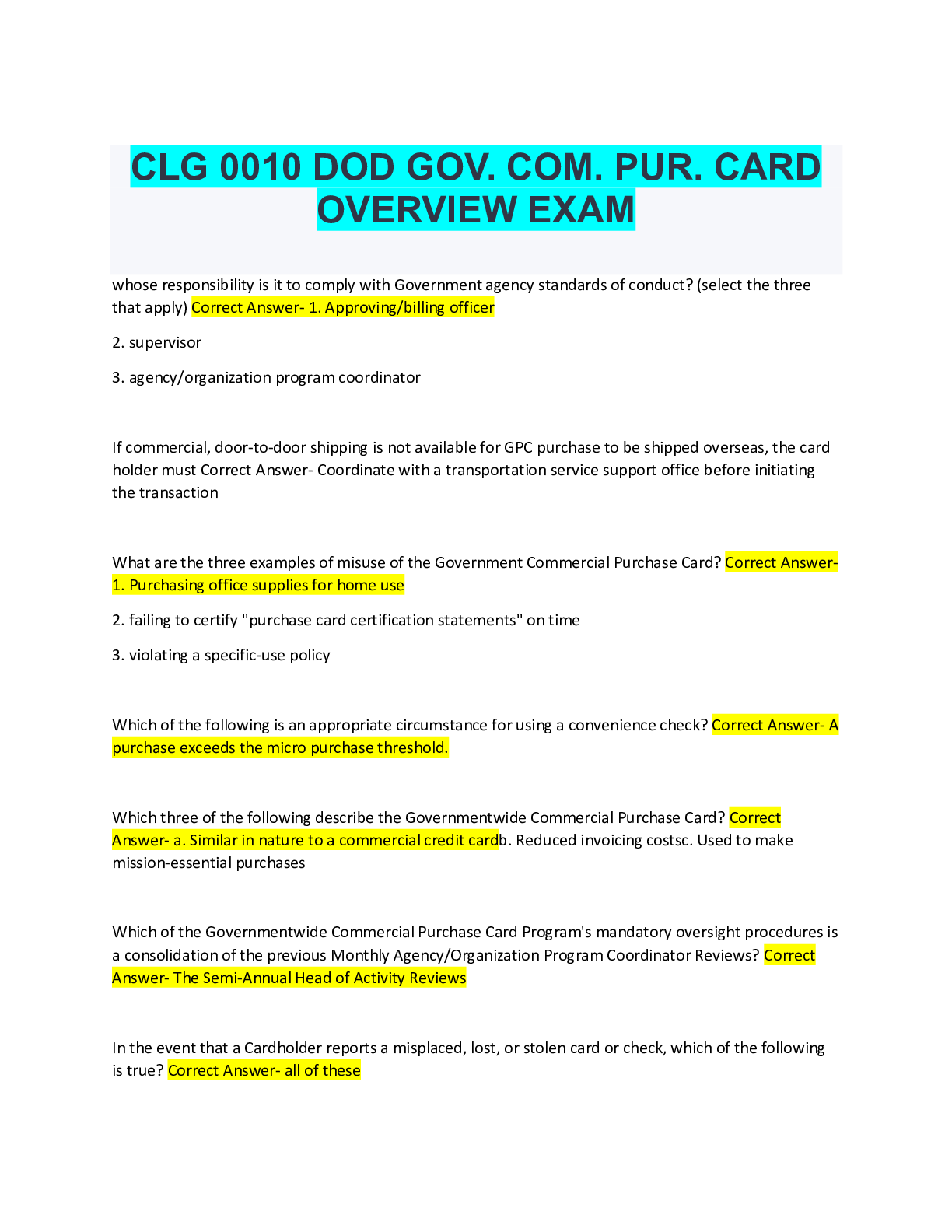
.png)
.png)



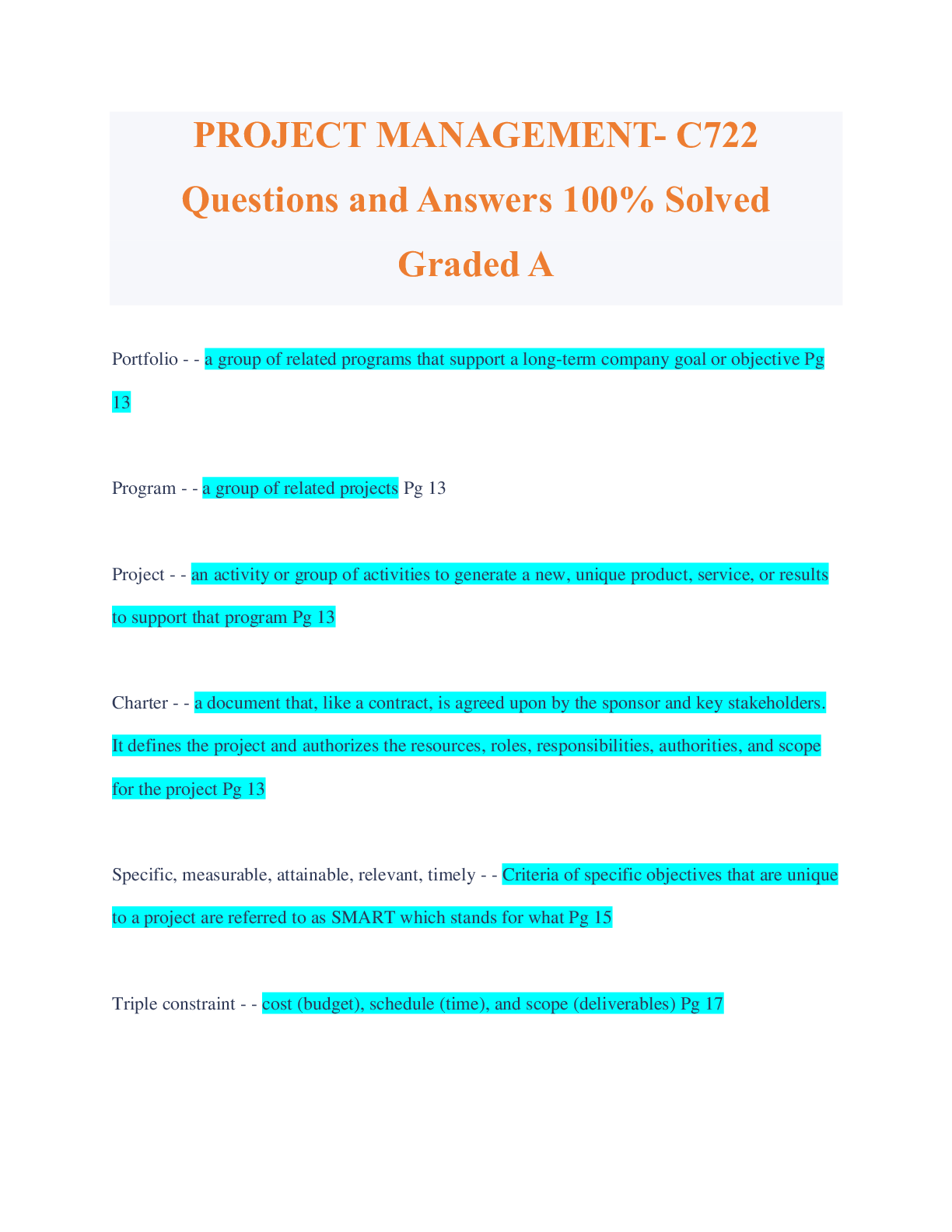
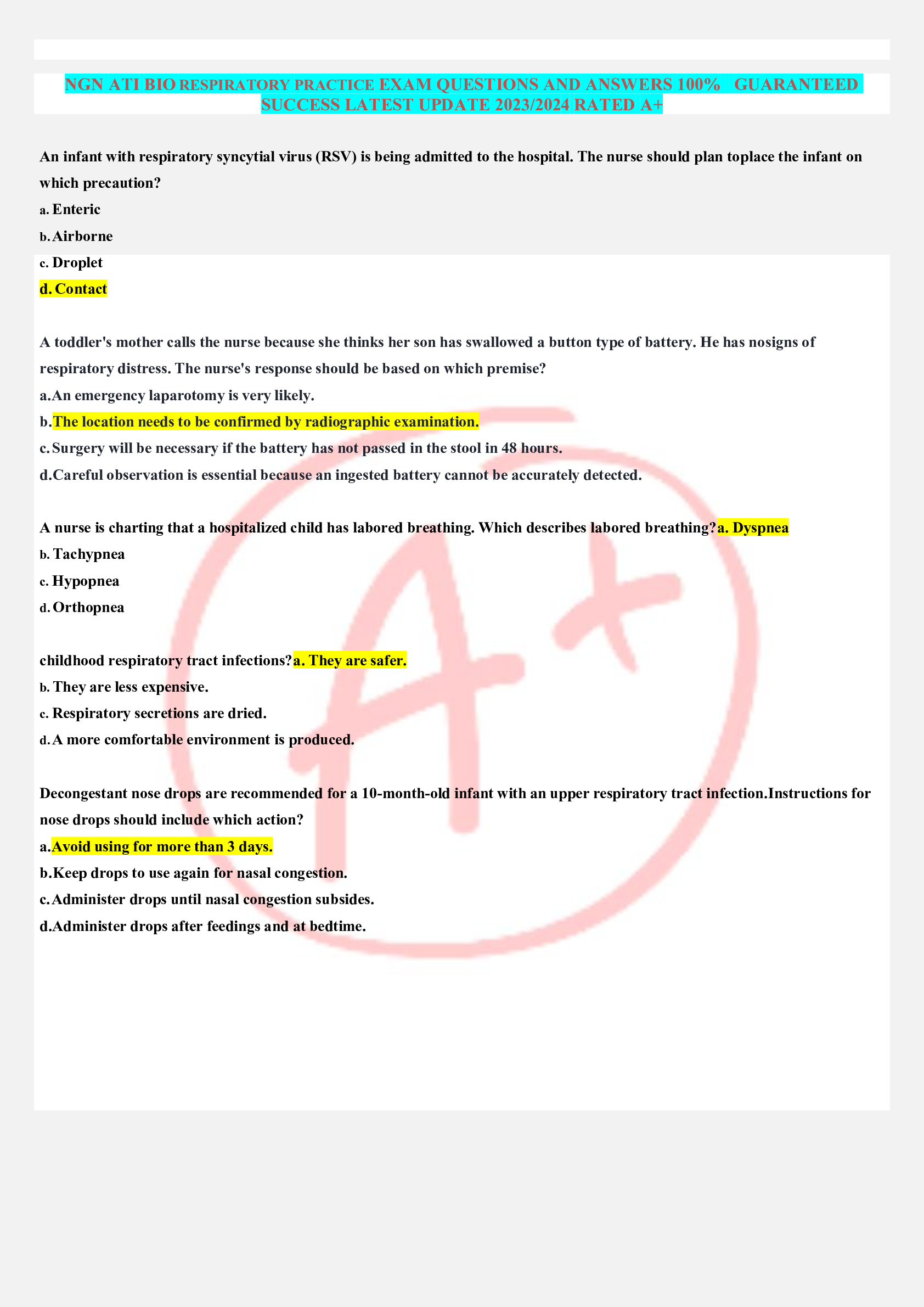
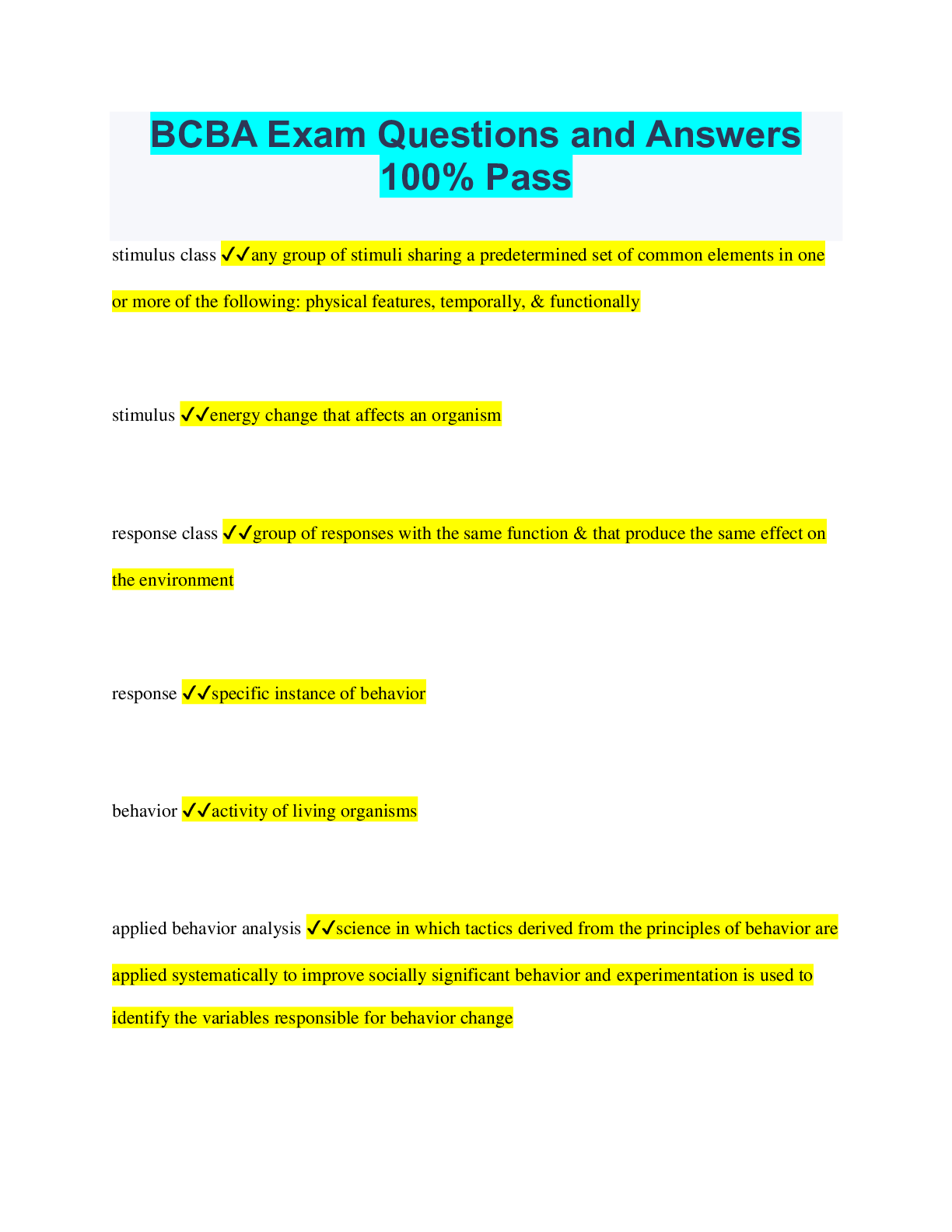
.png)
.png)
.png)
.png)
.png)
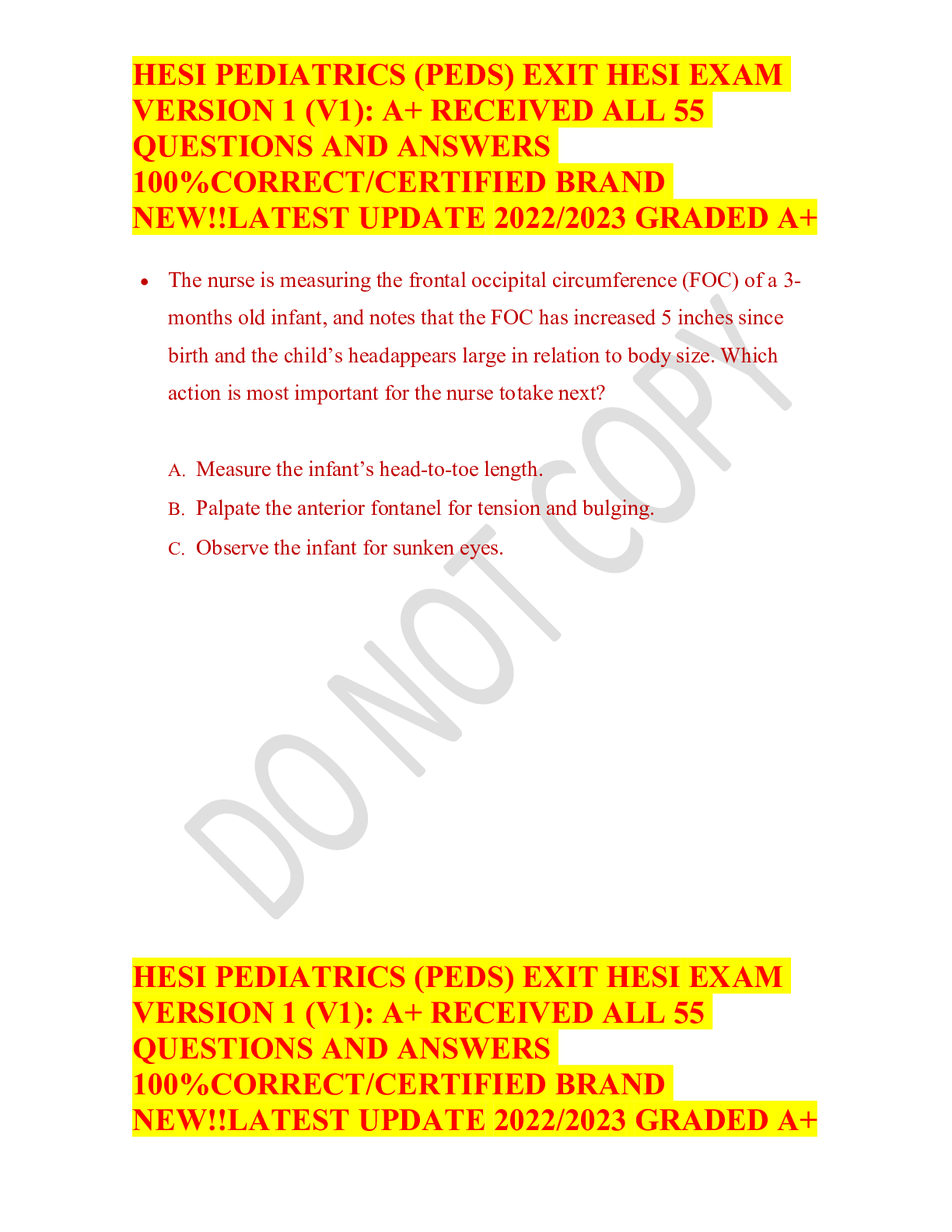
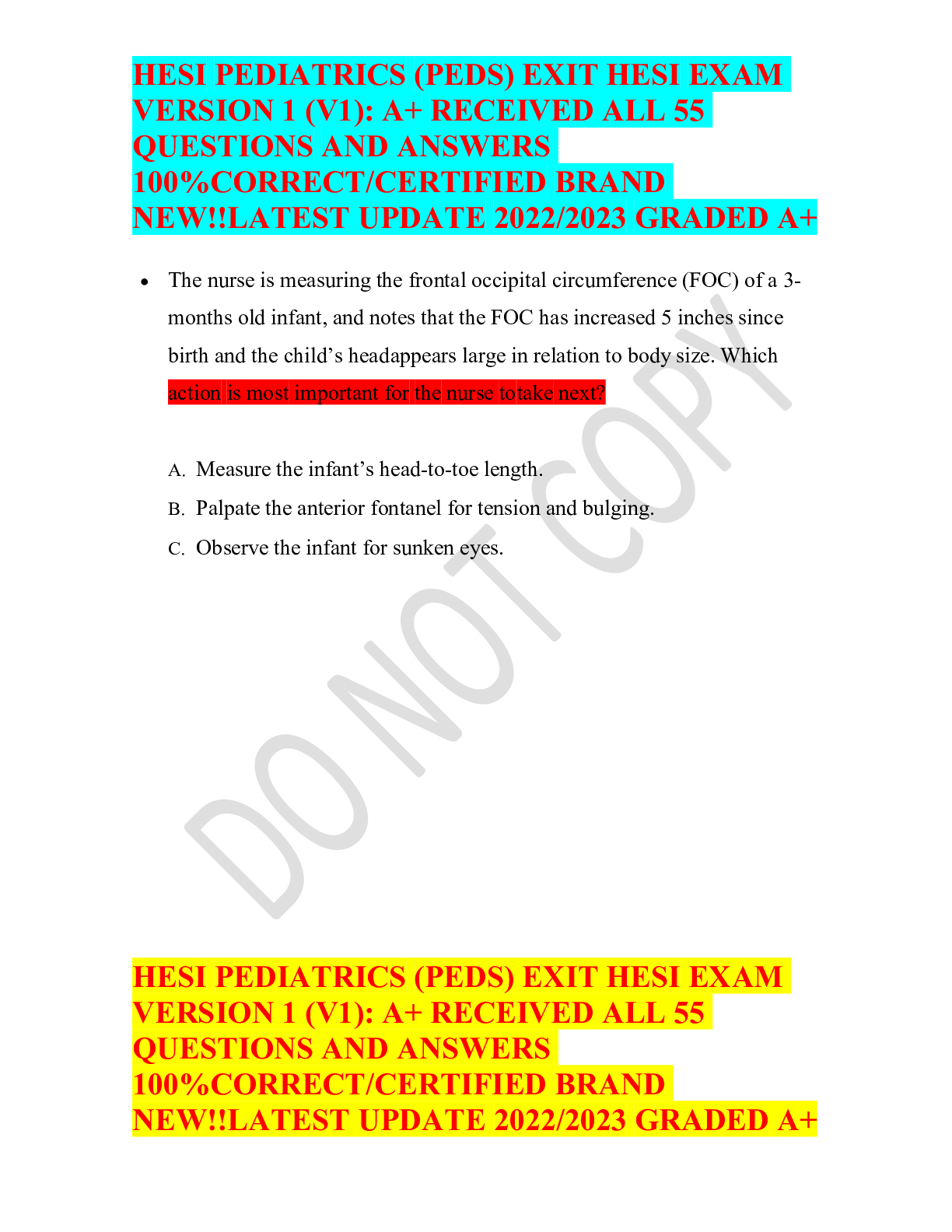
.png)
.png)

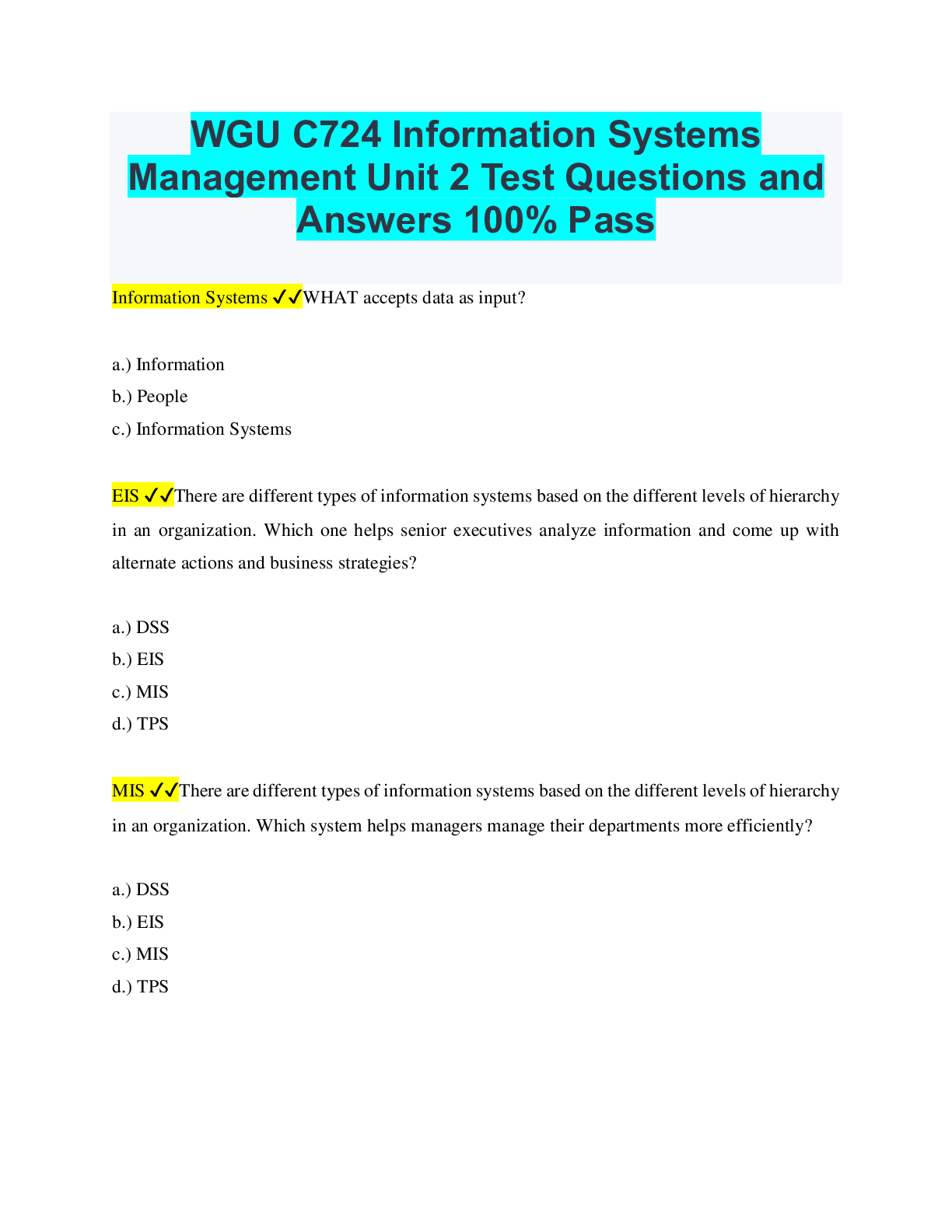
.png)

